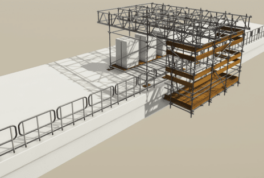When Should Scaffolds Be Designed?
When Should Scaffolds Be Designed?
We are often asked if particular scaffold arrangements ‘need’ to be designed. The HSE has compiled a list of scaffold arrangements they would expect to see. Confusion arises from the existence of TG20 guidance documents and historical practice within the industry. ‘TG20:08 A guide to good practice for Scaffolding with Tubes & Fittings’ is a document derived from ‘BS EN 12811 Temporary Works equipment – Scaffolds’ – the British Standard for the design and erection of scaffolds. TG20:08 attempts to interpret the requirements of BS and provides guidance notes for good practice in the design and erection of scaffolds. In addition to this, it reproduces several design tables from which the intention is certain configurations of the scaffold, if meeting the configuration arrangement, do not require any further design. Unfortunately, this has added to the confusion.
TG20:08 is very specific and prescriptive in the requirements of scaffolds which can be erected without further design such as where they are, the wind load on them, a maximum of 2m bays, a maximum of 2m lifts and whether they are netted or sheeted etc. Although your configuration may meet all the criteria, our guidance is – What does your Customer want?
You can argue the configuration does not require a design as it is TG20 compliant but if they want a design then you’ll have to do one anyway! Besides, there aren’t many large Contractors who would allow scaffolds to be erected on CDM sites without one, as they are often used for their own H&S and TWC management and they often need them to co-ordinate all trades who will be using the scaffold.
Scaffold structures that need to be designed
- Dead Shores
- Flying shores
- Raking shores
- Cantilevered scaffolds
- Truss-out Scaffolds
- Access Birdcages
- Façade retention
- Access scaffolds with more than the 2 working lifts allowed with TG20 ‘Basic Scaffolds’
- Buttressed free-standing scaffolds
- Temporary roofs and temporary buildings
- Support scaffolds
- Loading Bays founded on the ground
- Mobile and static towers outside base/height limitations
- Free standing scaffolds outside base/height Limitations
- Temporary ramps and elevated roadways
- Staircases and fire escapes
- Spectator Terraces and Seating Stands
- Bridge scaffolds
- Towers requiring guys or ground anchors
- Offshore scaffolds outside Offshore Contractors Association (OCA) handbook
- Pedestrian footbridges or walkways
- Slung and Suspended scaffolds
- Protection fans, Nets and Pavement Frames
- Marine scaffolds
- Boiler scaffolds
- Power line crossings
- Lifting gantries and towers
- Steeple scaffolds
- System scaffolds outside users guide parameters
- Sign board supports
- Sealing end structures
- Temporary Storage on Site
- Masts, Lighting Towers and Transmission Towers
- Advertising hoardings/banners
- Any scaffold structure subject to:
- Vibration
- High Loading
- Long term duration
- High risk areas
- Loading from passenger/goods hoists
Extracted from the HSE website.
Read more Technical Guidelines.








